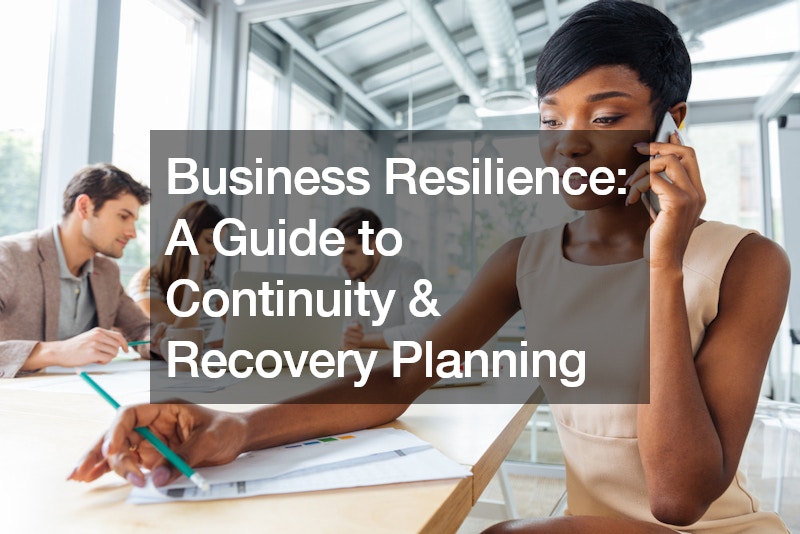In the business landscape, disruptions are inevitable. From natural disasters to cyber-attacks, unforeseen events can jeopardize operations and threaten the very existence of organizations. However, proactive planning through business continuity and disaster recovery strategies can fortify businesses against such challenges. Here are the essential steps in creating a resilient framework to overcome crises effectively.
Assigning Ownership
Business resilience begins with assigning ownership. Accountability is important in ensuring that continuity and recovery plans are not just theoretical documents but actionable strategies.
By designating individuals or teams responsible for overseeing these plans, organizations establish a clear line of authority and drive towards preparedness.
Furthermore, having dedicated ownership fosters a culture of responsibility and commitment to the resilience agenda throughout the organization. It encourages proactive engagement and ensures that continuity efforts remain a priority, even amidst competing business objectives.
Developing Policies
Policies serve as the foundation for continuity and recovery planning. They articulate the purpose, scope, and authority of the plans, providing a roadmap for implementation. Defining the objectives and boundaries of the plans helps align efforts across the organization and ensures a cohesive approach to resilience.
Additionally, clear and well-defined policies create transparency and facilitate communication both internally and externally. They serve as guiding principles for decision-making during crisis situations, empowering stakeholders at all levels to act swiftly and decisively to safeguard business interests.
Conducting Business Impact Analysis (BIA)
Understanding the critical functions of the business is essential for effective planning. Through a BIA, organizations identify key processes and prioritize them based on their impact on operations. This analysis provides insights into potential vulnerabilities and guides resource allocation towards mitigating risks.
In addition, conducting a BIA fosters a deeper understanding of the interconnectedness of various business functions and dependencies. It enables organizations to identify potential bottlenecks and single points of failure, allowing for targeted mitigation strategies to enhance overall resilience.
Performing Critical Analysis
Once key processes are identified, a critical analysis is conducted to assess associated risks and likelihoods. By quantifying the potential impact of disruptions and evaluating their probability, organizations can prioritize their response efforts. This step lays the groundwork for setting realistic recovery goals tailored to each service or function.
Critical analysis also enables organizations to adopt a proactive stance towards risk management. By identifying emerging threats and vulnerabilities, organizations can implement preemptive measures to mitigate potential impacts and enhance their ability to withstand disruptive events.
Establishing Recovery Goals
Recovery goals define the desired outcomes of continuity and recovery efforts. Maximum Tolerable Downtime (MTD), Recovery Time Objective (RTO), and Recovery Point Objective (RPO) are among the key metrics used to establish these goals. Organizations must align these goals with their operational needs and risk tolerance to ensure effective recovery strategies.
It’s important to note that setting recovery goals involves a careful balancing act between the desired level of resilience and the associated costs. While striving for minimal downtime and data loss is ideal, organizations must also consider the feasibility and affordability of achieving these objectives. By conducting a cost-benefit analysis and evaluating potential trade-offs, organizations can strike a balance between resilience and resource allocation.
Creating Recovery Strategies and Plans
With recovery goals in place, organizations develop comprehensive strategies and plans to address potential disruptions. These plans outline the steps to be taken during an event, including identifying recovery solutions, defining roles and responsibilities, and implementing contingency measures. By anticipating challenges and outlining response protocols, organizations can minimize downtime and mitigate losses.
In the development of recovery strategies and plans, it’s imperative to consider all possible scenarios that could disrupt business operations. One such scenario often overlooked is the breakdown of essential utilities, such as heating systems. One such scenario often overlooked is the breakdown of essential utilities, such as heating systems. For industries reliant on consistent temperature control, such as manufacturing or healthcare, a sudden boiler failure can bring operations to a grinding halt. This is where having contingency measures like considering a boiler hire becomes invaluable. By incorporating backup solutions into recovery plans, organizations can minimize downtime and maintain essential services during unforeseen circumstances.
Testing and Training
Testing and training are essential components of effective continuity and recovery planning. Regular testing of recovery plans helps identify gaps and weaknesses, allowing organizations to refine their strategies accordingly. Additionally, training personnel on their roles and responsibilities ensures a coordinated response during a crisis, maximizing the effectiveness of recovery efforts.
Maintaining Plans
Business continuity and disaster recovery plans are not static documents but living frameworks that require regular maintenance and updates. As organizations evolve and new threats emerge, plans must adapt to address changing circumstances. By staying proactive and agile, organizations can ensure that their resilience strategies remain effective in the face of evolving challenges.
In conclusion, business resilience is not just about weathering storms but thriving in the face of adversity. By following a systematic approach to continuity and recovery planning, organizations can minimize the impact of disruptions and emerge stronger from crises. From assigning ownership and developing policies to testing plans and training personnel, each step plays a crucial role in building a resilient framework that can withstand the uncertainties of the future. Embracing a proactive mindset and investing in preparedness today can safeguard the continuity and prosperity of businesses tomorrow.
.


